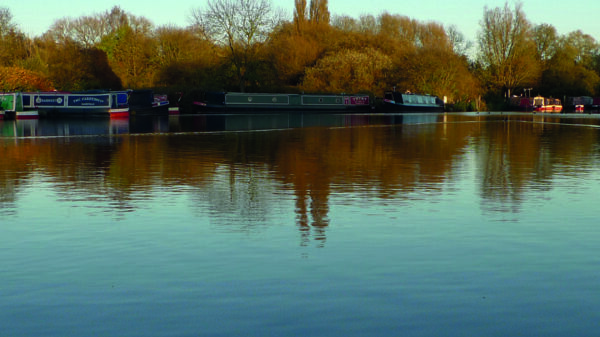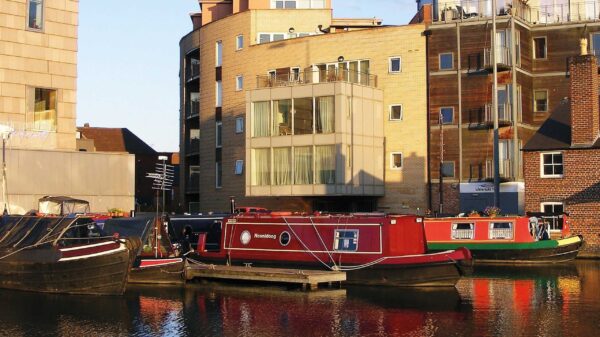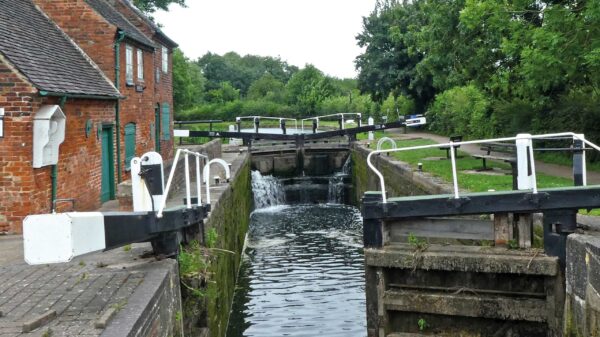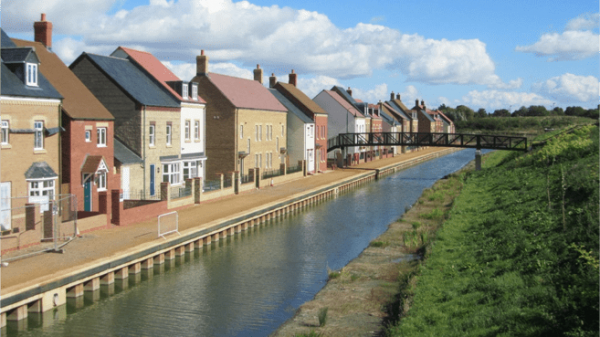Restoration Hub > Advice & Support > National Planning Policy Framework
National Planning Policy Framework
Written by Ed Gittins – 17th May 2012
This information identifies the main provisions of the National Planning Policy Framework and comments on how these are likely to affect England’s Inland Waterways in future. Waterway related points and key text is emboldened.
The National Planning Policy Framework (NPPF)
The NPPF sets out the Government’s planning policies for England and how these are expected to be applied. It does so in a condensed form of only 59 pages in total which replace a whole host of documents in the form of Planning Policy Guidance, Minerals Policy Statements & Guidance, and Planning Policy Statements as well as one Circular – Circular 05/2005: Planning Obligations.
The NPPF does not replace or diminish the force of Development Plans where these are in harmony with the NPPF. Thus the NPPF reaffirms that applications for planning permission must be determined in accordance with the Development Plan unless material circumstances indicate otherwise. One such ‘material circumstance’ could, of course, be that the Development Plan is not in accord with the NPPF.
The policies in the NPPF are material considerations which Local Planning Authorities must now take into account when determining Planning Applications or preparing new Local Plans. Policies in operative Local Plans adopted pre-2004 can still carry full weight if in harmony with the NPPF. For those Local Plans adopted since 2004 in accordance with the Planning and Compulsory Purchase Act 2004, full weight can be given to such policies up to 27th March 2013 even if there is a limited degree of conflict with the NPPF. (Whether such conflicts can be reasonably held to be ‘limited’ or not is likely to be a source of contention at Appeals and Inquiries in coming months). After the 27 March 2013, however, due weight should be given to relevant policies in existing plans according to their degree of consistency with the NPPF: the closer the policies in the Plan to the policies in the Framework, the greater the weight they may be given.
There is similar guidance in relation to emerging Plans. The weight to be attached to policies in emerging Plans will be governed by its stage of preparation, the extent to which there are unresolved objections, and the degree of consistency of the plan with the Framework.
Notwithstanding the Government’s aversion to Regional Planning, Regional strategies remain part of the list of documents in the Planning and Compulsory Purchase Act 2004 that local authorities must have regard to when preparing their
Local Plans. A footnote on page 40 of the NPPF states: “Regional strategies remain part of the development plan until they are abolished by Order using powers taken in the Localism Act. It is the government’s clear policy intention to revoke regional strategies outside London, subject to the outcome of the environmental assessments that are currently being undertaken.” Such uncertainty is hardly helpful to Local Authorities as they seek to progress their new Local Plans.
Local Planning Authorities are nevertheless now under enormous and immediate pressure to produce and adopt Local Plans which are up to date and consistent with the NPPF and to do so before 27th March next year. Failure to do so will expose existing and emerging Development Plans to challenge whereby national objectives and policies are then more likely to be determining factors than local considerations.
A period of frenzied plan-making is therefore about to commence throughout England resulting in the ‘rapid’ adoption of all manner of new and adapted policies and proposals. With ‘localism’ being at the heart of the process, and all new or revised Local Plans being the subject of Examinations leading to final decisions by Government Planning Inspectors, it is vital that the interests of inland waterways are safeguarded and promoted at the local level through the plan-making process. The NPPF is a good starting point for beginning to consider what action might be needed.
Key elements of the NPPF
This Planning Update now provides a selective summary of the various sections in the NPPF which appear to have implications for Inland Waterways.
Sustainable Development
The main thrust of the NPPF is to secure sustainable development. ‘Sustainable’ is defined as ensuring that better lives for ourselves does not mean worse lives for future generations. ‘Development’ is defined as ‘growth’. The planning system is seen to perform three particular roles: An economic role, a social role, and an environmental role. The Government does not want issues relating to these various roles to be assessed in isolation as it sees them as mutually dependent – taking local circumstances into account. That said, there is a strong focus or priority on securing economic benefits and removing planning obstacles to growth wherever possible. The NPPF is therefore one instrument in the country’s current battle to reduce national debt and unemployment.
Five bullet point aims are put forward as examples of pursuing sustainable development, with my highlighting:-
- making it easier for jobs to be created in cities, towns and villages;
- moving from a net loss of biodiversity to achieving net gains for nature;
- replacing poor design with better design;
- improving the conditions in which people live, work, travel and take leisure; and widening the choice of high quality homes; and
- widening the choice of high quality homes.
The above highlighting represents one of very few references in the NPPF with waterway connotations.
The NPPF introduces a ‘presumption in favour of sustainable development’ which it eloquently states: “…should be seen as a golden thread running through both plan-
making and decision-taking.”
The accent is strongly on positivity and efficiency. Thus, in plan-making, local authorities should positively seek opportunities to meet the development needs of their area, whilst for decision-taking, this means approving development proposals
that accord with the Development Plan without delay. Here, the NPPF indicates that where the Development Plan is absent, silent, or where the relevant policies are out- of-date, permission should be granted unless:
- any adverse impacts of doing so would significantly and demonstrably outweigh the benefits when assessed against the policies in the NPPF taken
as a whole; or - specific policies in the NPPF indicate development should be restricted.
The position is set out forcefully in paragraph 15 of the NPPF:
“Policies in Local Plans should follow the approach of the presumption in favour of sustainable development so that it is clear that development which is sustainable can be approved without delay. All plans should be based upon and reflect the presumption in favour of sustainable development, with clear policies that will guide how the presumption should be applied locally.”
It should therefore be borne in mind that the sustainability of waterway-related projects will become a prime consideration and that if such projects are endorsed by the Development Plan – they should proceed through the Planning Application process more smoothly in future.
Core Planning Principles
The NPPF identifies the overarching roles that the planning system ought to play in a set of 12 Core Planning Principles. These are set out in full below because they should be taken into account when promoting waterway-related projects or opposing development that harmfully affects inland waterways.
- be genuinely plan-led, empowering local people to shape their surroundings, with succinct local and neighbourhood plans setting out a positive vision for the future of the area. Plans should be kept up-to-date, and be based on joint working and co‐operation to address larger than local issues. They should provide a practical framework within which decisions on planning applications can be made with a high degree of
predictability and efficiency; - not simply be about scrutiny, but instead be a creative exercise in finding ways to enhance and improve the places in which people live their lives;
- proactively drive and support sustainable economic development to deliver the homes, business and industrial units, infrastructure and thriving local places that the country needs. Every effort should be made objectively to identify and then meet the housing, business and other development needs of an area, and respond positively to wider opportunities for growth. Plans should take account of market signals, such as land prices and housing affordability, and set out a clear strategy for allocating sufficient land which is suitable for development in their area, taking account of the needs of the residential and business communities;
- always seek to secure high quality design and a good standard of amenity for all existing and future occupants of land and buildings;
- take account of the different roles and character of different areas, promoting the vitality of our main urban areas, protecting the Green Belts around them, recognising the intrinsic character and beauty of the countryside and supporting thriving rural communities within it;
- support the transition to a low carbon future in a changing climate, taking full account of flood risk and coastal change, and encourage the reuse of existing resources, including conversion of existing buildings, and
encourage the use of renewable resources (for example, by the development of renewable energy); - contribute to conserving and enhancing the natural environment and reducing pollution. Allocations of land for development should prefer land of lesser environmental value, where consistent with other policies in this Framework;
- encourage the effective use of land by reusing land that has been previously developed (brownfield land), provided that it is not of high environmental value;
- promote mixed use developments, and encourage multiple benefits from the use of land in urban and rural areas, recognising that some open land can perform many functions (such as for wildlife, recreation, flood risk mitigation, carbon storage, or food production); conserve heritage assets in a manner appropriate to their significance, so that they can be enjoyed for their contribution to the quality of life of this and future generations;
- actively manage patterns of growth to make the fullest possible use of public transport, walking and cycling, and focus significant development in locations which are or can be made sustainable; and
- take account of and support local strategies to improve health, social and cultural wellbeing for all, and deliver sufficient community and cultural facilities and services to meet local needs.
It should be noted above that the 8th bullet point does not specifically require brownfield land to be released in preference to greenfield land.
Delivering Sustainable Development
The Government indicates that it is committed to ensuring that the planning system does everything it can to ensure sustainable economic growth. Planning policies should recognise and seek to address potential barriers to investment, including a poor environment or any lack of infrastructure, services or housing. It identifies a set of six requirements to ensure a positive approach to sustainable economic development.
One particular requirement relevant to waterways is the need to identify priority areas for economic regeneration, infrastructure provision and environmental enhancement.
Ensuring the Vitality of Town Centres
The NPPF reaffirms commitment to encouraging the vitality of town centres which was less strongly supported in the original draft. It retains the sequential approach whereby major commercial development should first seek town centre locations before edge of centre and out of centre locations are considered.
This should enable continued support to be given for waterside regeneration sites and projects within urban areas.
Supporting a Prosperous Rural Economy
The NPPF is equally as assertive in relation to the countryside. One of its key requirements is as follows;-
“To promote a strong rural economy local and neighbourhood plans should:-
- support the sustainable growth and expansion of all types of business and enterprise in rural areas, both through conversion of existing buildings and well designed new buildings;
- promote the development and diversification of agricultural and other land- based rural businesses;
- support sustainable rural tourism and leisure developments that benefit businesses in rural areas, communities and visitors, and which respect the character of the countryside. This should include supporting the provision and expansion of tourist and visitor facilities in appropriate locations where identified needs are not met by existing facilities in rural service centres; and
- promote the retention and development of local services and community facilities in villages, such as local shops, meeting places, sports venues, cultural buildings, public houses and places of worship.”
The highlighted third bullet point has particular relevance to waterway interests.
Promoting Sustainable Transport
Whilst no specific mention is made of inland waterway transport, the aim of facilitating sustainable transport is strongly supported. It states:-
“Plans should protect and exploit further opportunities for the use of sustainable transport modes for the movement of goods or people.”
Paragraph 34 states that: “Plans and Decisions should ensure that developments that generate significant movement are located where the need to travel will be minimised and the use of sustainable transport modes can be maximised. However, this needs to take account of policies set out elsewhere in this Framework, particularly in rural areas.”
The latter points indicate recognition that not all rural locations can meet the sustainability requirements.
Paragraph 35 states that : “Plans should protect and exploit opportunities for the use of sustainable transport modes for the movement of goods and people. Therefore, developments should be located and designed where practical to:
- accommodate the efficient delivery of goods and supplies;
- give priority to pedestrian and cycle movements, and have access to high quality public transport facilities;
- create safe and secure layouts which minimise conflicts between traffic and cyclists or pedestrians, avoiding street clutter and where appropriate establishing home zones;
- incorporate facilities for charging plug-in and other ultra-low emission vehicles; and
- consider the needs of people with disabilities by all modes of transport.
It is important to follow up this NPPF lead by securing policy commitments in the appropriate Local Plans to the promotion and development of sustainable commercial transportation using inland waterways and estuaries.
Protecting Green Belt Land
The NPPF retains the strength of Green Belt notation as previously set out in PPS2. The construction of new buildings continues to be regarded as inappropriate in Green Belt but there are certain specified exceptions, including:-
“Provision of appropriate facilities for outdoor sport, outdoor recreation and for cemeteries, as long as it preserves the openness of the Green Belt and does not conflict with the purposes of including land within it.”
Climate Change, Flooding and Coastal Change
The provisions of various defunct Planning Policy Statements in relation to the above reappear in summarised form in the NPPF.
There is no specific reference in the NPPF to flooding and flood risk in relation to navigation or recreation.
Promoting Healthy Communities
The NPPF encourages much greater public participation in determining local needs for open space and recreational facilities. Planning policies should be based on robust and up-to-date assessments of the needs for open space, sports and
recreation facilities and opportunities for new provision. Planning policies should protect and enhance public rights of way and access and could include towpaths, although such are not specifically mentioned. Adding links to existing rights of way networks including National Trails is suggested.
One innovative measure is the ability for local communities through Local and Neighbourhood Plans to identify green areas for special protection to be known as Local Green Spaces. The loss of these areas can be resisted unless there are very
special circumstances. The Government envisages Local Green Spaces will be located conveniently in relation to local communities, will relate to land having a special significance or recreational value, and generally will be local in character
rather than an extensive tract of land.
It is possible to consider the opportunities to promote Local Green Spaces in and around our inland waterways.
Conserving and Enhancing the Natural Environment
The NPPF provides continued support for statements and policies which previously appeared in Planning Policy Statements. Paragraph 115 of the NPPF states:
“Great weight should be given to conserving landscape and scenic beauty in NationalParks, the Broads and Areas of Outstanding Natural Beauty, which have the highest status of protection in relation to landscape and scenic beauty. The conservation of wildlife and cultural heritage are important considerations in all these areas, and should be given great weight in National Parks and the Broads.”
The reference to the Broads appears to be the only specific reference in the NPPF to an inland waterway.
Conserving and Enhancing the Historic Environment
The NPPF requires Local Planning Authorities to set out in their Local Plan a positivestrategy for the conservation and enjoyment of the historic environment, including heritage assets most at risk through neglect, decay, or other threats. Clearly this has major relevance to waterway-related heritage assets. It is therefore important to take into account the factors that will influence Councils in drawing up their strategy, namely:-
- the desirability of sustaining and enhancing the significance of heritage assets and putting them to viable uses consistent with their conservation;
- the wider social, cultural, economic and environmental benefits that conservation of the historic environment can bring;
- the desirability of new development making a positive contribution to local character and distinctiveness; and
- opportunities to draw on the contribution made by the historic environment to the character of a place.
In determining Applications Local Planning Authorities will require Applicants to describe the significance of any heritage assets affected, including any contribution made by their setting. When considering the impact of a proposed development on the significance of a designated heritage asset, great weight should be given to the asset’s conservation. The more important the asset, the greater the weight should be. Nevertheless, where a proposal will lead to less than substantial harm to the significance of a designated heritage asset, this harm should be weighed against the public benefits of the proposal, including securing its optimum viable use. In the case of non-designated heritage assets, a balanced judgement will be required having regard to the scale of any harm or loss and the significance of the heritage asset. All heritage assets will therefore be protected and if development involves the loss of the whole or part of the heritage asset, this will only be countenanced when the replacement new development is known and that such development is able to proceed.
Clearly the above guidance which replaces that formally contained within PPS5: Planning for the Historic Environment, will have many implications for both the protection and safeguarding of waterways’ heritage. It nevertheless recognises that change can sometimes be justified and in some circumstances can be beneficial. For example, the NPPF advises that Local Planning Authorities should assess whether the benefits of a proposal for enabling development which would otherwise conflict with planning policies but which would secure the future conservation of a heritage asset, outweigh the disbenefits of departing from those policies. Also, developers will be required to record and advance understanding of the significance of any heritage asset to be lost wholly or in part. However, the ability to record evidence of our past should not be a factor in deciding whether such loss should be permitted. ie. it is not a material consideration in support of any such loss.
Local Plans
As noted, key features are the need to promote and deliver sustainable development that reflects the vision and aspirations of local communities together with the need for Local Plans to be consistent with the principles and policies within the NPPF, including the presumption in favour of sustainable development.
Local Plans should set out the strategic priorities for the area covering the following:-
- the homes and jobs needed in the area;
- the provision of retail, leisure and other commercial development;
- the provision of infrastructure for transport, telecommunications, waste management, water supply, wastewater, flood risk and coastal change management, and the provision of minerals and energy (including heat);
- the provision of health, security, community and cultural infrastructure and other local facilities; and
- climate change mitigation and adaptation, conservation and enhancement of the natural and historic environment, including landscape.
Crucially, Local Plans should:
- plan positively for the development and infrastructure required in the area to meet the objectives, principles and policies of this Framework;
- be drawn up over an appropriate time scale, preferably a 15-year time horizon, take account of longer term requirements, and be kept up to date;
- be based on co-operation with neighbouring authorities, public, voluntary and private sector organisations;
- indicate broad locations for strategic development on a key diagram and land-use designations on a proposals map;
- allocate sites to promote development and flexible use of land, bringing forward new land where necessary, and provide detail on form, scale, access and quantum of development where appropriate;
- identify areas where it may be necessary to limit freedom to change the uses of buildings, and support such restrictions with a clear explanation;
- identify land where development would be inappropriate, for instance because of its environmental or historic significance; and contain a clear strategy for enhancing the natural, built and historic environment, and supporting Nature
Improvement Areas where they have been identified.
It is clear that many of the above elements in the plan-making process will impinge on our canals and rivers in terms of their character and use. Having regard to the time frame involved for the adoption of new Local Plans, the coming months will see the release of hundreds of planning consultation documents throughout England with policies and proposals which will potentially affect waterside environments and projects. Urgent consideration needs to be given as to how the interests of the Inland Waterways are to be safeguarded and promoted in the light of locally produced consultation documents issued by English Local Authorities as well as in the form of Neighbourhood Plans. Information needs to be disseminated and draft Plans monitored. Vigilance is therefore required and representations will need to be submitted to both promote waterway projects and interests and oppose development which is deemed harmful to the Inland Waterways.
Section 110 of The Localism Act contains a “duty to cooperate” between neighbouring plan-making authorities and this principle is carried forward into the NPPF. Clearly this is vital in relation to canal restoration projects which cross Local Authority boundaries. Presumably the same “duty to cooperate” will apply to Local Authorities with waterways which cross national boundaries such as the Llangollen and the Montgomery – although the NPPF does not apply in Wales. Where waterway projects do cross Local Authority boundaries, the involvement of IWA Branches and affiliated Societies and Trusts in the planning process will become all the more vital.
Conclusion
It should be clear from the above that the Localism Act and the NPPF will have far-reaching implications for the future of the English waterways system. The NPPF includes extensive safeguards for the protection of the environment including heritage assets. It is nevertheless unashamedly allied to securing growth and to support economic development subject to meeting sustainability and environmental objectives as well. The need to provide up to date Local Plans by late March 2013 will see the imminent publication of many draft planning consultation documents and the holding of Local Plan Examinations within a very condensed time frame. Moreover, the opportunities offered by the Localism Act for the preparation of
Neighbourhood Plans will create an extra layer of plan-making which will also need to be monitored. However, where Neighbourhood Plans are being prepared for areas with Inland Waterways, there will be opportunities for waterway enthusiasts to participate directly in the formulation of such Plans. Urgent decisions need to be taken as to how best to safeguard and promote the future of the Inland Waterways through the emerging Plans. From the Restoration Committee’s perspective, if the appropriate monitoring of and participation in the Plan process can be successfully undertaken at the local level, there is a golden opportunity to safeguard and advance restoration projects, including those which cross Local Authority boundaries.
The key question is how best can this be promoted, organised and achieved?
Edward Gittins
17th May 2012
Download this National Planning Policy Framework Overview
This document includes references to the Localism Act 2011 which are not included in the text above.
(80.93KB)
DownloadOur use of cookies
We use necessary cookies to make our site work. We'd also like to set optional analytics cookies to help us improve it. For more detailed information about the cookies we use, see our 'Cookie Policy page'.Edit preferences Accept
Privacy Overview
| Cookie | Duration | Description |
|---|---|---|
| __stripe_mid | 1 year | Stripe sets this cookie to process payments. |
| __stripe_sid | 30 minutes | Stripe sets this cookie to process payments. |
| cookielawinfo-checkbox-advertisement | 1 year | Set by the GDPR Cookie Consent plugin, this cookie records the user consent for the cookies in the "Advertisement" category. |
| cookielawinfo-checkbox-analytics | 1 year | Set by the GDPR Cookie Consent plugin, this cookie records the user consent for the cookies in the "Analytics" category. |
| cookielawinfo-checkbox-functional | 1 year | The GDPR Cookie Consent plugin sets the cookie to record the user consent for the cookies in the category "Functional". |
| cookielawinfo-checkbox-necessary | 1 year | Set by the GDPR Cookie Consent plugin, this cookie records the user consent for the cookies in the "Necessary" category. |
| cookielawinfo-checkbox-others | 1 year | Set by the GDPR Cookie Consent plugin, this cookie stores user consent for cookies in the category "Others". |
| cookielawinfo-checkbox-performance | 1 year | Set by the GDPR Cookie Consent plugin, this cookie stores the user consent for cookies in the category "Performance". |
| CookieLawInfoConsent | 1 year | CookieYes sets this cookie to record the default button state of the corresponding category and the status of CCPA. It works only in coordination with the primary cookie. |
| PHPSESSID | session | This cookie is native to PHP applications. The cookie stores and identifies a user's unique session ID to manage user sessions on the website. The cookie is a session cookie and will be deleted when all the browser windows are closed. |
| Cookie | Duration | Description |
|---|---|---|
| _fbp | 3 months | Facebook sets this cookie to display advertisements when either on Facebook or on a digital platform powered by Facebook advertising after visiting the website. |
| _ga | 1 year 1 month 4 days | Google Analytics sets this cookie to calculate visitor, session and campaign data and track site usage for the site's analytics report. The cookie stores information anonymously and assigns a randomly generated number to recognise unique visitors. |
| _ga_* | 1 year 1 month 4 days | Google Analytics sets this cookie to store and count page views. |
| _gat_gtag_UA_* | 1 minute | Google Analytics sets this cookie to store a unique user ID. |
| _gat_UA-* | 1 minute | Google Analytics sets this cookie for user behaviour tracking.n |
| _gid | 1 day | Google Analytics sets this cookie to store information on how visitors use a website while also creating an analytics report of the website's performance. Some of the collected data includes the number of visitors, their source, and the pages they visit anonymously. |
| CONSENT | 2 years | YouTube sets this cookie via embedded YouTube videos and registers anonymous statistical data. |
| Cookie | Duration | Description |
|---|---|---|
| test_cookie | 15 minutes | doubleclick.net sets this cookie to determine if the user's browser supports cookies. |
| VISITOR_INFO1_LIVE | 5 months 27 days | YouTube sets this cookie to measure bandwidth, determining whether the user gets the new or old player interface. |
| YSC | session | Youtube sets this cookie to track the views of embedded videos on Youtube pages. |
| yt-remote-connected-devices | never | YouTube sets this cookie to store the user's video preferences using embedded YouTube videos. |
| yt-remote-device-id | never | YouTube sets this cookie to store the user's video preferences using embedded YouTube videos. |
| yt.innertube::nextId | never | YouTube sets this cookie to register a unique ID to store data on what videos from YouTube the user has seen. |
| yt.innertube::requests | never | YouTube sets this cookie to register a unique ID to store data on what videos from YouTube the user has seen. |








